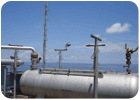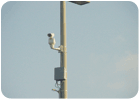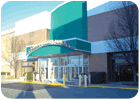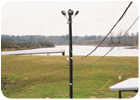

Perimeter security can further complicate an outdoor installation, as the perimeter often lacks power and lighting. Parking lot security systems, which also seem to be on the rise, pose similar challenges.
In this article,SDMlooks at five different organizations and their approach to outdoor security needs — as well as how dealers and integrators have used advanced technology and products to address the unique challenges of installing and maintaining these outdoor security systems.

Aircraft manufacturer Gulfstream Aerospace tightened its
perimeter security with PTZ cameras.
Cameras Clean Up Aircraft Hangar
Two years ago, aircraft manufacturer Gulfstream Aerospace had a fairly unsophisticated security system at its sprawling Savannah, Ga. facility. “When I came on board two years ago, they had four cameras,” notes Alan Nutes, Gulfstream’s manager of security services. “They brought me on to revamp their entire security program.”Nutes’ first priority was to install a single-point access control system to control entrance to the facility. He enlisted the help of Stanley Security Solutions, an Indianapolis-based systems integrator that has numerous branch offices, and together, the decision was made to install an access control system from Lenel Systems International, Rochester, N.Y.
“They were trying to protect their employees, their assets and their customers,” says Adele Pierce, a Stanley account manager who works closely with Gulfstream and its 12 locations. “The goal is to have all of their locations on the Lenel system with a server in Savannah,” Pierce adds.
Gulfstream’s access control system is tightly integrated with video surveillance. “For every card reader, there is a camera,” says Nutes. The initial system attracted so much attention within the company that more and more departments began inquiring about how they could enhance their own security.

With the help of Stanley Security Solutions and access
control from Lenel Systems International, Gulfstream Aerospace keeps unwanted
visitors out of its facilities.
To address the department’s needs, Nutes says, “We installed PTZ cameras in the bays themselves that managers can view any time they want. They can also call up archival information.” PTZ cameras were also installed outside the hangar where the aircraft pull up — and even the cameras installed inside the hangar were of the type suitable for outdoor use, as the large hangar doors are often left open.
The service center archives already have proved valuable. When Gulfstream was blamed for damage to an aircraft, the company was able to use archived images to determine that the damage was actually caused by a vendor. “We saved over $300,000,” Nutes recalls. “With that incident alone, the system paid for itself.”
As more departments installed security systems, it caused the Lenel access control system to evolve into what Nutes calls “an enterprise-wide” system. It also drove the need to create a security operations center.
“We were bringing in so many cameras and card readers that we needed a central location to monitor it all, rather than just a security post monitor,” explains Nutes. From the security operations center, security personnel can view images from cameras throughout the system, including those that have now been installed at other company locations.
Another important security system expansion was a project requested and paid for by Gulfstream’s research and development department. It involved installing 48 cameras, including numerous outdoor cameras, and 28 doors to protect a parking lot and to control entry to a newly constructed R&D center. The parking lot cameras have provided an important benefit to employees. Previously there had been a lot of keying incidents in the parking lot — 35 in the month before the cameras were installed alone. But in the first 20 months after the cameras were installed, there was only one incident.
Today Nutes continues to be busy with additional plans for the system. “The service center managers are telling everyone about the ROI on the cameras, and entities we never suspected are saying they want cameras,” he says.

Security Services and Technologies installed a FLIR thermal
camera atop a tower to secure the perimeter of a chemical facility.
Chemical Plant ‘Sees’ in Complete Darkness
When a large chemical company set out to secure the perimeter of several of its manufacturing facilities, the goal was to use video cameras so that when the perimeter was violated, security personnel would be alerted and could view the scene. But there was a major problem: large parts of the perimeters were unlit.“To put in lighting would have cost millions of dollars,” says Ryan Loughin, global director of sales for Security Services and Technologies (SST), the Philadelphia-based systems integrator that installed the chemical company’s security system. “A lot of the plants are located on several thousand acres and there is no infrastructure for lighting at the ends of property.”
The solution was to use thermal imaging cameras from FLIR Systems, Wilsonville, Ore., which Loughin says can “see” in complete darkness. The manufacturer makes vision systems with infrared technology for a variety of industries and applications, including security surveillance. “We saved the client millions for the simple fact that we didn’t have to put in lighting,” he adds.
The FLIR cameras work closely with a video analytics system from ObjectVideo of Reston, Va. By processing the pixels from the FLIR cameras, Loughin explains, the ObjectVideo system addresses another challenge of outdoor security systems — the need to distinguish human intruders from animals that also may cross the perimeter. “You write the rules,” he says. “You could have an alarm go off if someone is coming through the virtual perimeter, but not go off if they’re exiting — and you can differentiate between a deer and a human or a car and a human. It cuts down on false positive alarms — where you get an alarm, but it’s not the one you want. It’s cut our false positives to virtually zero.”
Another important element of the security system is a fiber-optic detection system installed on the fence line, from FiberSensys of Hillsboro, Ore. “It tells the command center if anyone tries to climb the fence or break zones and a PTZ camera goes to the zone,” says Loughin.
Shipping Ports Follow Moving Targets
Since 9/11, the nation’s shipping ports have tightened security immensely. One example is the Illinois International Port District, which enlisted Siemens Building Technologies, Buffalo Grove, Ill., to install a sophisticated perimeter and video surveillance system to protect two facilities. These include Iroquois Landing, a facility with 3,000 linear feet of ship and barge berthing space located at the mouth of the Calumet River at Lake Michigan; and Calumet Harbor, which has 6,000 linear feet of docking space located farther up the Calumet River. Both facilities also have several large transit sheds.Before the security system was installed, the port relied solely on 24-hour guards at entry points for security. Today the guards are still there, but how they are deployed is driven by an advanced video surveillance system. After consulting with Siemens, the port’s security management made the decision to purchase a sophisticated video analytics system from Vistascape Security Systems, Atlanta.
With input from numerous cameras installed around the perimeter of the facility, the Vistascape system presents a single unified three-dimensional view of the entire harbor, which is monitored by personnel at an on-site operations center. “You almost have a satellite view of the facility,” explains Pete Vitone, security solutions sales manager for Siemens' Midwest district. “You have the entire harbor and you can visually see and know what’s moving on it.”
The port security system also includes an access control system that controls gate entry. “The concept was to secure the perimeter along the fence line,” Vitone says. Surveillance cameras cover the entire perimeter. “Think of it as a virtual wire,” he says. “Once you cross that virtual line you would immediately get notification to the operations center.”
The system also has built-in intelligence that can gauge how fast and in what direction vessels or other targets are moving. Additionally, Vistascape can be programmed to recognize and treat individual situations differently. “We have virtual regions of interest,” Vitone says. “You can set different policies for different areas.” Unauthorized movement involving a petrochemical tenant, for example, might be given a higher priority than some other events.
Another feature of the system is the ability to automatically track a moving target using a PTZ camera. “As long as you don’t take control of the PTZ, it will track it,” Vitone explains.
Siemens was so impressed with the Vistascape system that it purchased the company in September 2006 as a wholly owned subsidiary.

Supreme Security Systems, Union,
N.J., installed a mall security system that
uses a wireless mesh network and IP cameras, enabling police officers to view
video from inside their vehicles.
Police Patrol Mall Virtually
When local police set out to install an indoor and outdoor video surveillance system at the Livingston Mall in Livingston, N.J., the initial plan was to use wired cameras to enable police to remotely view the mall from the police station.“A couple of companies bid on it, but the prices were way too high,” notes Jeremy White, sales representative for Supreme Security Systems of Union, N.J., the company that ultimately installed the mall’s security system. “They included union labor to pull the wire.”
Supreme Security Systems re-bid the job based on using a wireless mesh network from Firetide Inc., Los Gatos, Calif., to connect IP cameras to secure the mall and parking lot. That system not only was less expensive; it had other benefits as well.
“Using wireless mesh, we were able to give them a more sophisticated system,” White says. One benefit, White says, is the ability to expand the security system easily in the future.
Each IP camera in the Livingston Mall installation is connected to a Firetide node, which communicates wirelessly with other nodes in the system. An automatic discovery mode enables new nodes to easily join the network, making the system flexible and easily expandable. The automatic discovery mode also had another benefit that had strong appeal to the police department.
“The manufacturer mentioned that we could put a node into a police car patrolling the lot,” explains Supreme Security vice president and chief operating officer David Bitton. “The police officer has a computer in the car and can view all cameras inside and outside of the mall from the cruiser.”
The IP cameras used for the installation are of a megapixel design from IQinvision, San Clemente, Calif. The police have been impressed with the quality of images from the cameras. “They were totally blown away on the quality,” White adds.

At this water-processing plant, weatherproof Protech sensors
help eliminate false alarms, and when combined with video surveillance, footage
can be viewed to determine the cause of an alarm.
Water Treatment Plant System Keeps False Alarms in Check
“When you’re doing an outdoor security system, the challenge is that you don’t want to have something that goes off constantly — and it’s a major challenge,” notes Chris Dunn, president of 3D Maximum Security, a systems integrator based in Henderson, Tex.When 3D Maximum Security was enlisted to install a security system for a reservoir and water-processing plant for a local community, the goal was to use motion sensors integrated with video surveillance cameras. Concerned that animals, wind and similar common occurrences could generate a high number of false alarms, Dunn made a point of using motion sensors from Protection Technologies Inc. (Protech), Sparks, Nev., that are designed specifically for outdoor use.
“Protech offers a unique outdoor sensor that uses a Doppler-type effect,” explains Dunn, adding that the product is highly accurate. “Every time the wind blows or a cat walks through, it’s not setting off an alarm.”
Dunn says local authorities love the system at the water-processing plant, which includes sensors on all water tank hatches and on all buildings and doors. In the past, Dunn explains, “Any time you had an issue, they would have to send a sheriff or police and they would end up staying there for hours. Now they can turn around if they have an alarm, pull up the video and view whatever they’re trying to see and decide if they are dispatching.”